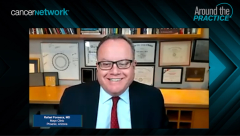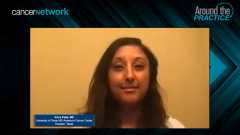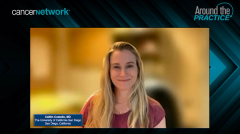
First-Line Treatment Options for Transplant-Ineligible NDMM: Focus on MAIA Trial
A review of the available first-line treatment options for transplant-ineligible multiple myeloma, as well as the design and findings of the MAIA study.
Episodes in this series

Rafael Fonseca, MD: We’re now going to discuss the treatment of patients who are transplant ineligible. We saw quite a few studies presented at the recent ASH [American Society of Hematology annual meeting]. The development of combination strategies has been previously presented in our session as the way to go. There’s clearly a tendency for 4 drugs. Is that something that we want to also do for transplant-ineligible patients? Let’s start with you, Dr Patel. These are critical questions about a tailored approach to these patient populations. What factors should be taken into consideration when you think about frontline therapy? This is a little agnostic from the drugs itself, but what are the factors that you’re taking into consideration as you face treatment selection for these patients?
Krina Patel, MD: This is a great question. Being a former transplanter, Bob can close his ears, before I joined from the dark side to the light side to the myeloma department, I’d say that everybody was eligible for transplant. That definition of what transplant ineligible is matters in terms of what I think is OK and proper to treat. If someone is truly transplant ineligible, they have to have organ failure, where they’re not going to be able to do well with a transplant. Usually those are my frail patients, either lungs or heart for the most part. Then I tailor my therapy according to that toxicity. In Texas, we have a lot of patients who have things like metabolic syndrome or neuropathy, so I’m also monitoring my dosing of bortezomib, for instance.
I tend to use triplets, and usually it’s VRd [bortezomib, lenalidomide, dexamethasone]–lite vs the MAIA DRd [daratumumab, lenalidomide, dexamethasone]. If the patient has horrible asthma or COPD [chronic obstructive pulmonary disease], I might go with the VRd-lite. I tend to do more DRd now because a once a month injection is a lot easier for patients to take. It depends on their comorbidities and performance status, but those are the 2 main ones that I go for.
Rafael Fonseca, MD: Dr Matous, speaking of ineligibility for transplant, we saw an update on the MAIA study. We’re going to talk a little more about MAIA as well, but can you review what was presented by Thierry Facon, [MD,] and the rationale, study design, efficacy, etc for MAIA?
Jeff Matous, MD: Sure. It’s difficult to locate a truly transplant-ineligible patient in my world, but I know it’s happened. The MAIA trial is truly practice-changing. It changes the standard of care of our patients who we deem to be transplant ineligible. MAIA was a trial that accrued over 700 patients and randomized patients between Rd [lenalidomide, dexamethasone] and Rd plus daratumumab. We know from previous studies that Rd is a very good option for older, frail patients. The daratumumab was given until disease progression in that arm.
In my opinion, this is a more real-world trial than some of the other studies that have been done in transplant-ineligible patients. For example, SWOG S0777 was a transplant-ineligible study, but the patients were younger on that trial. In this trial, the median age was 73, and most of the patients were between 75 and 90 years of age.
What we learned from this trial with the longer follow-up presented at the 2021 EHA [European Hematology Association Virtual Congress] was that there was an overall survival benefit to the triplet compared with the doublet, even with nearly 50% crossover between the doublet arm to getting further therapy with the daratumumab later. That’s impressive. DRd has become my go-to off trial for transplant-ineligible patients for another reason: avoiding peripheral neuropathy. It’s challenging to avoid peripheral neuropathy in older patients. When we treat anybody, we want long survival and excellent quality of life. The MAIA trial demonstrated that DRd is an excellent way to achieve that for this population of patients.
Rafael Fonseca, MD: You made some excellent points, including about the crossover. That’s all impressive. It shows that sometimes it’s hard to catch up. It goes back to the message, “Use your best treatment from the get-go.” In particular, a major plus is the issue with peripheral neuropathy. Dr Costello, what are the implications for your clinical practice based on what has been published and reported recently at the ASH meeting regarding MAIA? And if you don’t mind, perhaps we can start comparing that with POLLUX, which is a different patient population—relapsed and refractory—but the same regimen.
Caitlin Costello, MD: Sure. With MAIA, we finally got that 5-year follow-up that showed what Dr Matous just mentioned: a very clinically meaningful overall survival improvement, about a 30%-plus reduction in the risk of death. What are we doing if we’re not saving lives? The combination of daratumumab, lenalidomide, and dexamethasone for our transplant-ineligible patients offers a dramatic, clinically significant change to our practice.
Historically, we’ve put patients who are transplant-ineligible on doublets or RVd-lite or RVd, and crossed our fingers and hoped the neuropathy wasn’t too bad. Most patients are “eligible” for the combination of DRd. There are very few patients for whom I have hesitations to give this to. It allows for longer treatment. You don’t have to stop the bortezomib after a certain period of time with DRd. Patients do well with it. In the midst of a pandemic, it’s practical to realize that the addition of daratumumab may provide a little more immunosuppression or immunocompromise and put patients more at risk of COVID-19, so that has been something that we’ve had to reckon with in the past couple of years. But I feel like daratumumab-Rd is probably the new standard of care for transplant-ineligible patients, particularly in an older population.
Rafael Fonseca, MD: Those are all excellent points. Do you do dose adjustments in your practice with the medications, or do you start everyone at the standard doses?
Caitlin Costello, MD: I try to go big or go home. What we’ve all been seeing here is we want to put our best foot forward as much as we can to get an early and deep response. It’s real, though, that patients who are on DRd per MAIA are going to be on Revlimid [lenalidomide] for the long run. Being on lenalidomide for the long run is challenging. You can have significant fatigue, concentration concerns, and diarrhea, all which can affect quality of life. So while I often [adjust for] renal disease or renal function, assuming otherwise, I try to start them at a full dose and dose reduce accordingly, depending on how they’re tolerating it for the long run. My goal is to keep them on it, so I want to make those adjustments to make that happen.
Transcript edited for clarity.
Newsletter
Stay up to date on recent advances in the multidisciplinary approach to cancer.






































































































